Carrying a proper medical kit—and knowing how to use it—can mean the difference between your best day and your worst day in the field.
We’ve all been out with friends and had someone come away with a minor injury. Maybe it’s a sprained ankle, a cut finger, or a skinned knee. A little injury where you simply brush the dirt away, shake yourself off, and continue on down the trail. But what happens when the injury exceeds “minor” status? Do you know what to do if a gun misfires and now someone has a gunshot wound? Or your hunting buddy falls from the tree stand and suddenly has a compound fracture? It’s oh-so-easy to get caught up in planning and executing a successful hunt, but what happens when something goes wrong?
One of the most important pieces of gear for anyone who steps foot off the pavement, a solid first-aid kit is especially important for hunters. Whether you are heading into the backcountry for a multi-day hunt or simply hitting your favorite trails for the day while setting trail cams, a first aid kit should always be in your backpack. Don’t think of the kit as a fixed item—the contents within your first-aid kit should change per trip… you’re going to want a beefier assortment for an 11-day Dall sheep hunt in the Alaska backcountry than you will for a simple morning in the tree stand five miles from home. You may choose to go with an ultralight kit to save weight and space or a broader selection if you are in hunting camp. Never assume the outfitter, your hunting buddy, or someone else along the trail will have a medical kit: always be ready to take care of yourself.
Carrying a well-stocked first aid kit, however, doesn’t do much good if you don’t know how to use it. Consider taking a CPR / Wilderness First Aid course; the course typically runs over two eight-hour days and can be found in most communities for less than $250. It’s a small investment for the knowledge you’ll gain of how to respond correctly when things go wrong, and in the heat of the moment the ability to be certain of your treatment decisions and keep a level head is crucial—whether it’s yourself or a fellow hunter that’s injured.
The book Wilderness Medicine: Beyond First Aid by Dr. William Forgey is an excellent primer for home study. Having the kit is one part, but having the knowledge of how to use the kit is most important.
So, first gain the working knowledge and then assemble your kit.
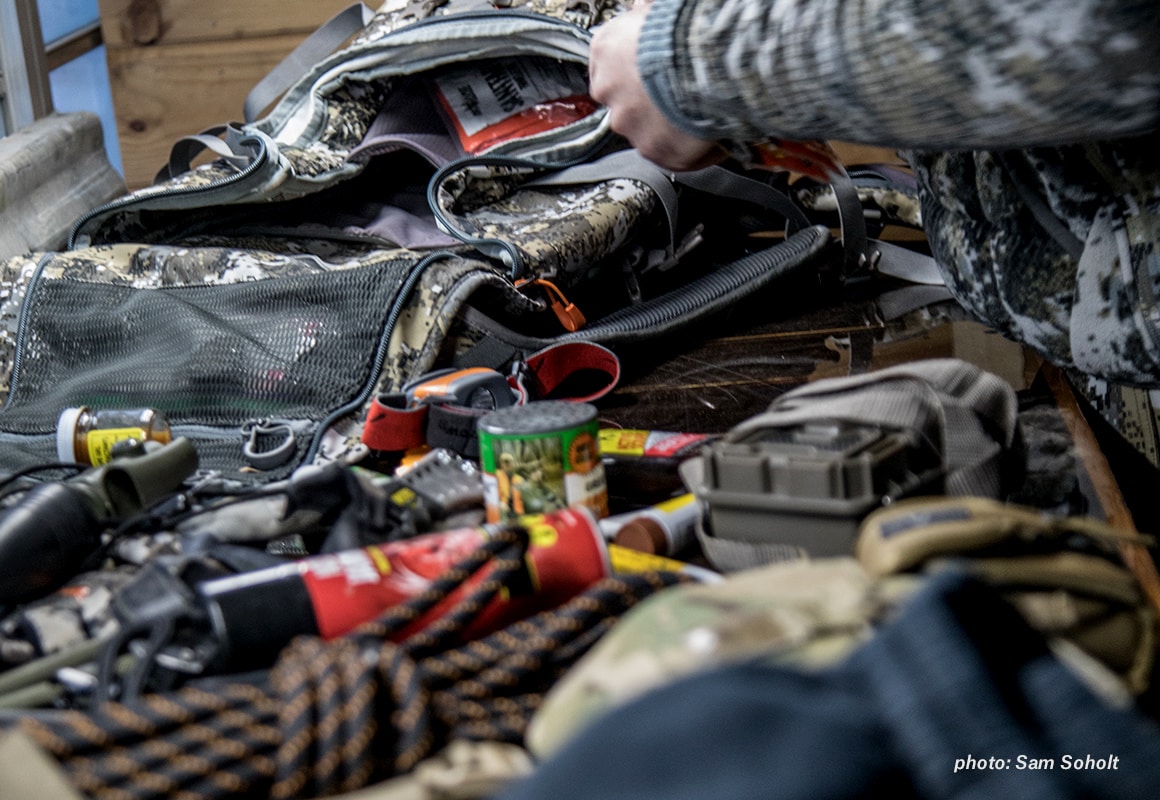
James Pyke, an instructor at Missoula, Montana-based Aerie Backcountry Medicine, recommends anyone going on an off-grid hunt prepares with the following:
- Take a Wilderness First Aid or Wilderness First Responder course
- Prepare a med kit with supplies you have inspected and know how to use—don’t rely on a pre-packed kit from an outdoors store
- Know the medical history and prescription medications of the other members of your trip
- Leave a comprehensive plan with someone in town who will have your safety in mind while you’re gone
- Plan for proper hydration and nutrition
- Pack proper layers and extra layers
- Have a solid plan for communication
- Save your updates Offline Maps to your onX Hunt account and confirm they’ve downloaded completely by taking your phone off cell service and looking at the maps
Seasoned hunting industry photographer and onX Hunt Ambassador Steven Drake notes, “I always take a mini first aid/what-if kit with me every time I go into the mountains. It’s been slimmed down and refined over the years; it’s always a balance of space, weight, and practicality.” Among other things, he notes he’ll never leave home without a SOL emergency bivy and a QuikClot Advanced Clotting Sponge.
If a hunter could only bring five medical items into the field, Pyke recommends:
- Personal protective equipment (surgical masks, medical gloves, eye protection)
- Hemorrhage control (tourniquet, pressure wrap supplies)
- Chest seal for penetrating chest trauma
- Dressings for blisters and other small open wounds
- Communication device (cell phone and/or satellite device depending on location)
“I would highlight two technologies that every hunter should be aware of and utilizing appropriately,” Pyke adds. “Firstly, tourniquets: every wilderness first aid course now includes curriculum on proper tourniquet application, and folks should now be expected to know how to apply these in cases of massive hemorrhage. At a minimum, people should look up a “Stop the Bleed” course which is generally one to two hours and quickly highlights how to utilize direct pressure and tourniquets to stop severe hemorrhage. There is no longer an excuse for people to be ignoring the efficacy of tourniquets.”
Secondly, he lists satellite communications as a critical piece of technology.
“Satellite communication devices have improved so much in even the last 10 years. The connection and functionality of these devices makes them mandatory equipment for outdoor recreationalists. There are many devices to choose from, so just send an emergency signal, some let you text custom messages, either way people should be able to utilize this technology to call for help if things go wrong. Choose a device, test it regularly and make sure you keep it charged. The ability to let someone know your exact location could be the difference between a positive or negative outcome of an emergency.”
(In addition to satellite comms, another good plan for onX Hunt users is to create and share Waypoints or Tracks for touchpoints on your trip, so if you miss your scheduled return or check-in, family and friends have a starting point to initiate a search.)
Other items you should consider carrying in your kit include:
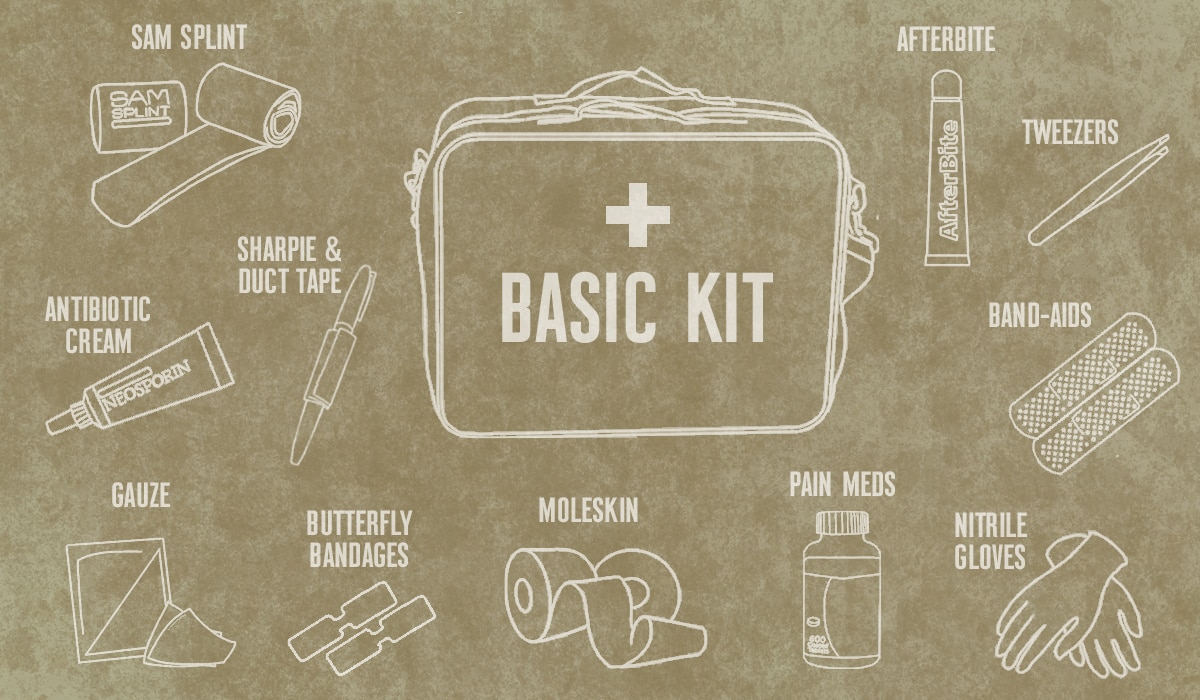
The Basic Kit
Adventure Medical Kits makes a series of very solid first aid kits, from one-person single-day kits all the way up to expedition-grade. It’s a good idea to keep a “mini-kit” within your larger kit so you can grab the basics if you’re going on a quick scout away from base camp. This smaller kit holds the basics for dressing small wounds and minimal medications on hand for cuts, scrapes, blisters, and the lot, while remaining portable enough to slot easily into a pocket or daypack. Consider including gauze sponges, band-aids, butterfly bandages, prep pads, moleskin, tweezers, allergy ointment, antibiotic cream, ibuprofen, nitrile gloves, duct tape, Sam splint, AfterBite, towelettes, a Sharpie marker (wrap the duct tape around it to save space), a space blanket, and medical tape in the mini-kit.
Tim Burnett of SOLO HNTR (and onX Ambassador) adds something else to his basic kit. “Wet Ones singles are a must-have,” he notes. “I like the citrus.”
Wound Management
Celox, QuikClot, or another hemostatic agent should always be in your kit, ready to stop bleeding quickly until proper medical care can be found. If you are trained and confident in giving sutures, pack along a suture kit; if not, Steri-Strips or butterfly bandages are important to bring along. Super Glue can also help seal a wound until proper medical care can be attained.
Consider receiving training on how to use a chest seal (an occlusive dressing used when an open chest wound occurs). Train how to use the seal—sucking chest wounds are extremely dangerous and need to be treated appropriately.
Another item to consider is a pressure dressing—a non-adherent bandage covered by an absorbent layer and then a stretchable adhesive. Pressure bandages (a stretchable adhesive) are designed to hold the bandage and absorbent layer close to the wound while applying pressure; helping to stop bleeding and allow clotting to begin.
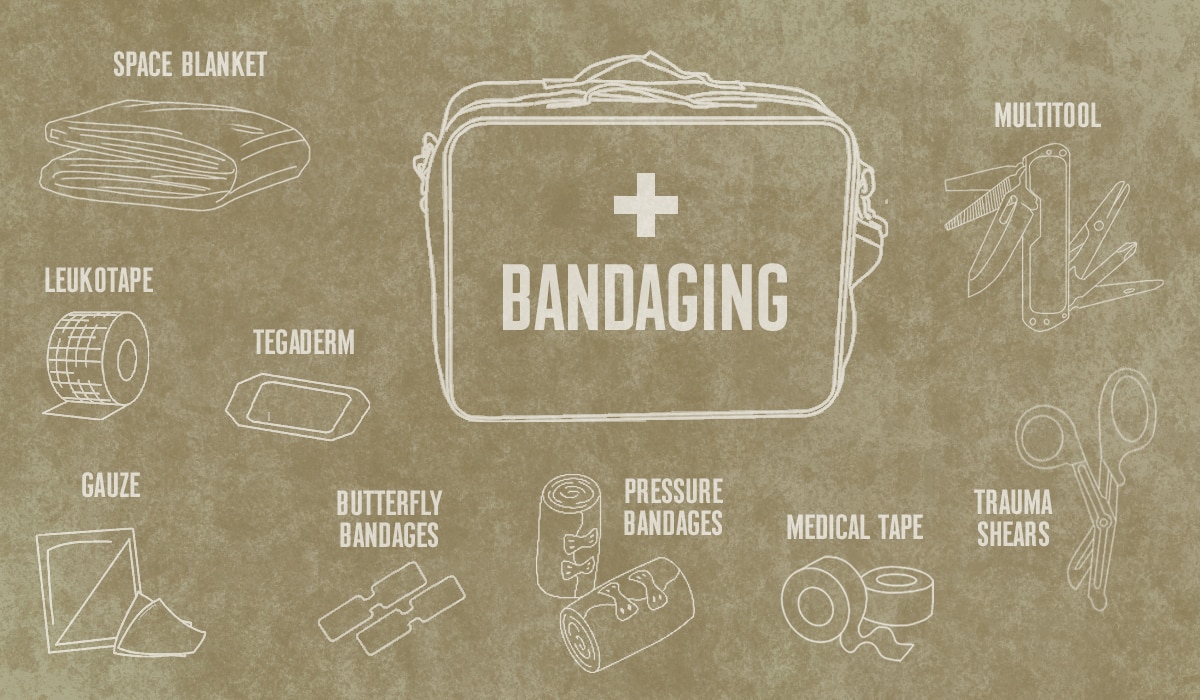
Bandaging
While you should have some basic bandaging supplies in your mini-kit, pack a broader selection in your main kit. Gauze rolls, tape, pressure bandages, gauze pads, tegaderm, and Co-Flex wrap provide an easy, effective way to wrap and re-wrap wounds. Throw in a bit of Leukotape (stick pieces to release paper so you don’t have to carry the entire roll) for blisters or joint immobilization.
A multi-tool or your hunting knife is handy for cutting tape or gauze as needed; pack along trauma shears if you have the space and weight allowance.
Medications
Medications: one of the most important—and ever-evolving—aspects of any medical kit. Know what you need for your own system; some people find certain medications more effective than others. While this list is highly individual, consider at least covering these categories:
- Benadryl tabs (or other antihistamine of your choice): Important to keep on hand for possible allergic reactions. It’s a good idea to pack an EpiPen® along as well.
- Benzocaine (Orajel or other): If you’ve ever had tooth problems in the woods, this requires no explanation.
- Consider packing along relevant cold and allergy medicines.
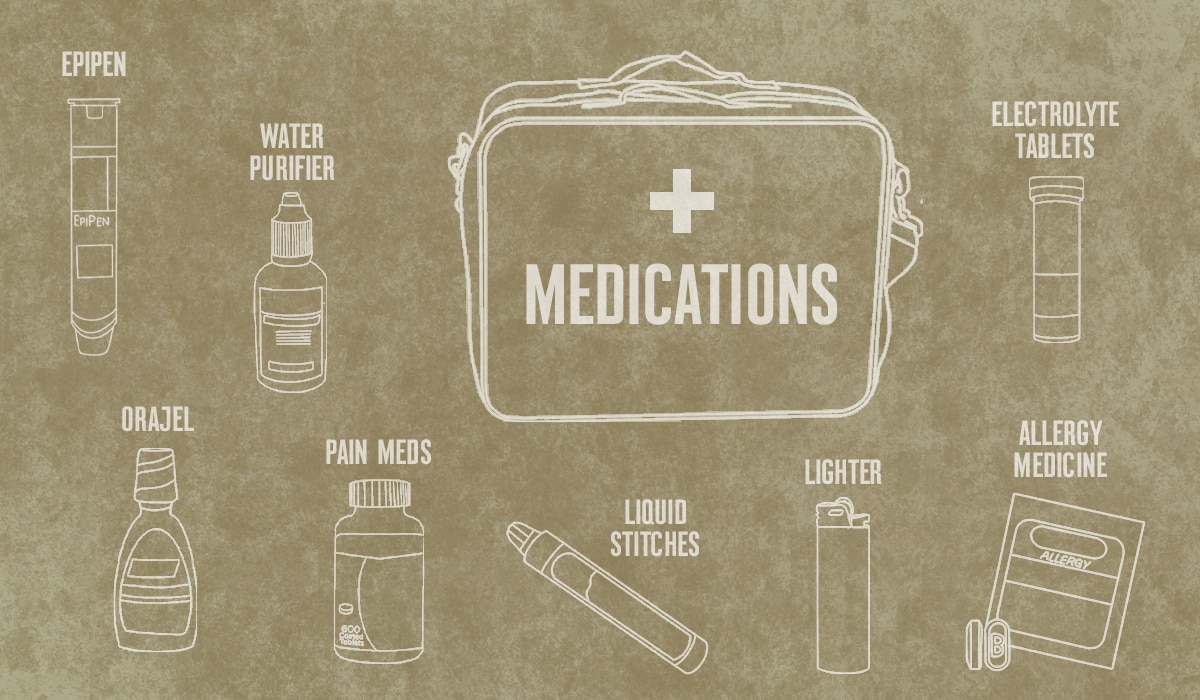
- Water treatment tabs: Even if you hunt with a water filtration device, pack a few of these as a back-up. Should something happen to your filter, you can still have potable water.
- Ibuprofen: Headaches, backaches, body aches, fever… you name it.
- Electrolyte tabs: Most electrolyte tabs barely take up any space or weight and can be a day saver for hot, early-season hunting. Drop one in your water bottle and sip throughout the day, or refuel with one once you’ve reached evening camp.
Montana hunter and onX Ambassador Jana Waller carries a small, custom first-aid kit containing liquid stitches, a spare lighter, and cough drops among other supplies. The surprise item, she notes, is baby aspirin. “It’s good to carry it in case someone in your party is having symptoms of a heart attack,” she notes. “Placed under the tongue (up to 350 mg), it’s quick-dissolving and a good preventative measure.”
Fit all your meds into their own, labeled baggie within your kit. Keep an eye on expiration dates and update as necessary.
A Note on Tourniquets
A tourniquet is an important part of a first-aid kit, but can be problematic in the hands of people who do not know how to use it. If you choose to carry a tourniquet, do your research, buy a quality one and learn how to use it properly.
Certainly pack along the materials for a pressure bandage: gauze 4x4s, gauze rolls, and Ace bandages. Celox Blood Clotting Agent (available over the counter) can be dumped into the wound prior to applying a pressure wrap. In most cases if a well-administered pressure wrap won’t stop the bleeding, then it’s time to consider a tourniquet.
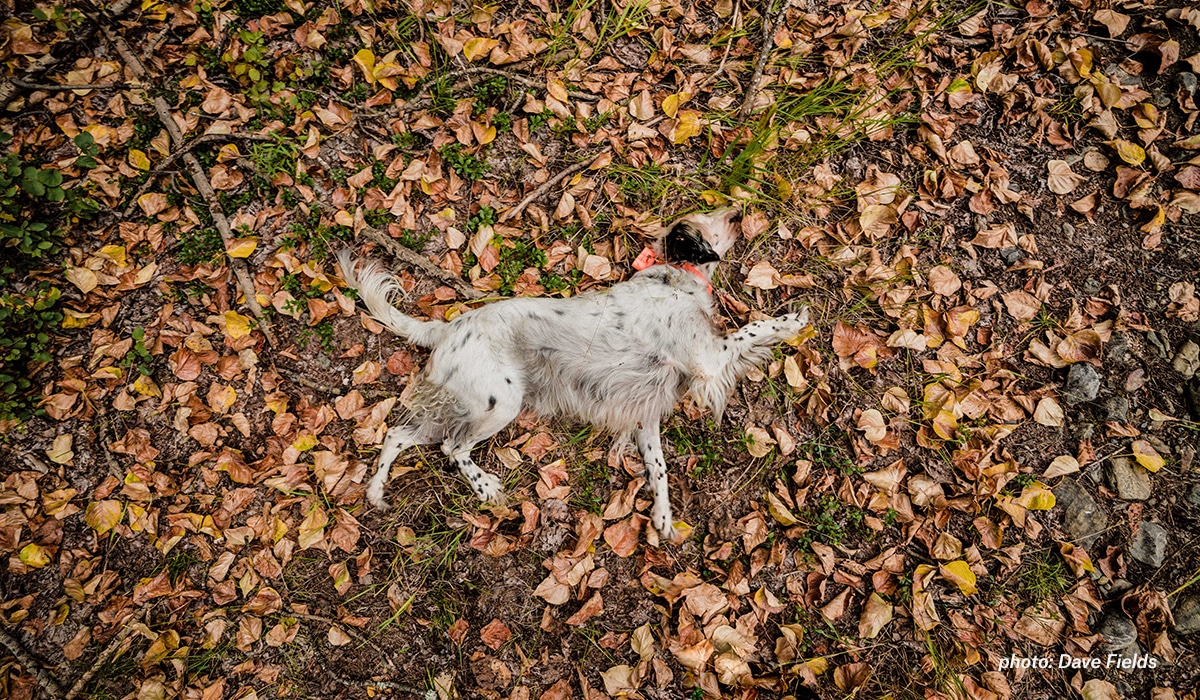
Dog Owners
Upland and waterfowl hunters should give thought to carrying a separate section in their medical kit for dogs. While the majority of the items in this kit can cross over, consider adding pediatric Benadryl, buffered aspirin, a thermometer, and even a travel bottle of hydrogen peroxide for canine medical concerns.
Read our blog “Preseason Preparation for Bird Dogs and Hunters” for thoughts and tips from onX Ambassador Brandon Moss and Shawn Wayment, DVM, on preseason canine conditioning as well as emergency field care and preparation.
Organization
Keeping your kit organized is crucial. Many outdoorsmen like to keep items in each category in separate Ziplock baggies within a larger bag—often a dry bag, which can easily be clipped onto vehicles or packs. This modular system allows the user to easily find what they are looking for without digging through the entire kit. It’s also easier to mark what needs to be replaced upon the return home. Ease of use and consistent maintenance is key.
Cold Weather Preparation
In many parts of the country, late-season hunts take place in cold, wet, and often miserable conditions. Conditions which, without the proper preparation and care, can quickly become dangerous. Wilderness medical professionals like Aerie Wilderness Medicine’s Pyke are always attuned to the dangers of inclement weather.
“One of the most preventable, high frequency events for folks hunting or recreating outdoors in the fall/winter has to be cold-stress or hypothermia,” Pyke shares. “People can work to prevent hypothermia by being properly hydrated, maintaining proper nutrition and planning ahead with proper layers, footwear and gloves. It is also a good idea to carry extra, dry layers and gloves in case of saturation by sweat, snow or rain.
“For folks heading out for a weekend hunt in cold temps I would always recommend having a good plan for hydration, nutrition and proper layering. One aspect, however, that many folks overlook is a solid plan with other people in town who can provide assistance or call the appropriate agencies in case things go wrong. If the forecast is for sub-zero temps, you have a greatly diminished margin for error and things can become dire quickly.”
Pyke recommends your emergency response plan includes, at a minimum:
- Start / end point
- A detailed map/description of the planned area of travel that can be passed to responders
- Expected duration of the hunt or activity
- Communication method or lack thereof (satellite communications were discussed above)
- A specific time that outside help should be initiated if communication has not been established
Bottom line: at the beginning of every trip, talk with your fellow hunters and ensure they know you have a kit and what’s in it. Some people may need fast access to particular medications and it’s important to know who has what gear and where it is. In areas where snakes or other poisonous creatures are a concern, talk realistically about steps to be taken if someone is bitten… it can be sobering, but it’s important to ensure no time is wasted if and when action is needed.
While it may seem obvious to bring a more complete first aid kit for trips further into the backcountry, many hunters find themselves doing just the opposite: carrying less to save ounces. In reality, the further away from medical help you find yourself, the more first-aid items you should be carrying.
This list is in no way intended to be a final or complete guide, or to serve as a replacement for any sort of formal medical advice. Use it as a starting point to review your own first aid practices in the field. If something were to happen, are you prepared? Do you have the training necessary to manage wounds in the field? Perhaps your own medical kit is about ten years out of date?
Above all: review, refresh, and remain prepared.